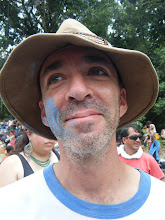 |
| Staring at the sun - Chimborazo |
With a summit reaching 6310m (20,702 ft) above sea level the volcano Chimborazo is the highest point in Ecuador. Because the Earth bulges at the equator Chimborazo is also the closest point on our planet to the sun -- or furthest from the center of the earth for inward thinkers. With serious climbing gear, a serious guide and a serious ability to withstand altitude sickness it is possible to reach the peak. We are anything but serious.
For common visitors, like us, it is very accessible to get to 5,000 m (16,404 ft) with very little effort which is pretty awesome. I have never been at this altitude in my life and that includes living at the edge of the Rocky Mountains for four years. Chimborazo is an easy day trip from the city Riobamba where we are staying.
We take a bus going to Guaranda and ask to get dropped off at the entrance to Chimborazo park. Our driver and his helper forget about us and luckily Mika spots the entrance from the window as we whiz by it. We get dropped off about two kilometers from the entrance which actually turns out to be a good thing. We immediately hitch a ride with an older Ecuadorian couple going back the other way who happen to be local tourists also headed to Chimborazo. They make room for us moving aside blankets and heavy coats.They are obviously much better prepared than we are.
 |
| Our first snow of 2011 |
The entrance to the protected area is $2. The guidebook and some other blogs by foreigners say the entrance is $10. The tourist info office in Riobamba told us it is $2. The Ecuadorian guy driving thinks that the entrance is $1 for locals, but they have to pay $2 too. From the entrance it is a winding eight km (five miles) road past grazing vicuña (a wild relative of the llama and camel) to the first shelter which sits at 4800 meters.
 |
| View of Chimborazo at the first shelter, 4800 meters |
From here it is a 200 m walk up to the second shelter. The beginning of the trail passes tombstones of climbers who died attempting to touch the sun at Chimborazo's peak. The walk is relatively short, but long. Walk fifty meters catch our breath, another fifty, breathe and rest. I now have a greater appreciation for oxygen than I used to.
 |
| Honoring fallen climbers |
At the second shelter we are rewarded with the fact that we are now at exactly 5000 meters and with a hot chocolate sold by a park ranger at the next shelter. It is quite windy. Clouds are blowing in and around the volcano from different directions. Sometimes Chimborazo is hidden in clouds, then it will clear up the sun shows itself and we warm up to pristine views of Chimborazo in all its glory.
Since we were able to hitch a ride up to the first shelter, we are not so tired and decide that we will walk down the 8km to the main road. Our main purpose for doing this is to get a better glimpse of the vicuña.
 |
| Wool worth? |
The vicuña live only in the South American Andes and are known to have finest wool in the world. During Inca times it was illegal to kill them and only royalty could wear vicuña wool which they would round up and shear every four years. I think even today only royalty can afford to wear vicuña wool. A stole made from the fine fibers easily costs over $1000.
Also today it is illegal to kill vicuñas. In the 1960's their population on the continent was whittled down to only 6,000. Currently there are several hundred thousand most of which are in Peru. To prevent poaching they are now shorn every two years.
Also today it is illegal to kill vicuñas. In the 1960's their population on the continent was whittled down to only 6,000. Currently there are several hundred thousand most of which are in Peru. To prevent poaching they are now shorn every two years.
As we move down the mountain the barren landscape is a stark contrast to the lush greenness we are used to seeing in the Andes. We encounter several small groups of vicuña dotting the scenery with their beige and white coats.
I am quite sure that they hear us well before we see them. As we try to approach closer to get a decent photo some of them will move away quickly while others lift up their heads stare directly at us and then casually walk in the other direction. If we stand still they eventually get back to the business of grazing on the scrubby plants.
We finally make our way down to the main road back to Riobamba. We have just cut across the mountain bypassing the park road and skipping the ranger station at the entrance unsure if we were supposed to let them know we are leaving. I hope they are not still looking for us. We flag down a pick up truck and have a breezy, dusty ride back to town as Chimborazo gets smaller in the distance.
 |
| Chimborazo at 60 mph |
 |
| Early evening view from the unused train station |
 |
| Is the name of this restaurant in honor of the 18th US president, or a dig at Americans' large eating habits? |
















No comments:
Post a Comment